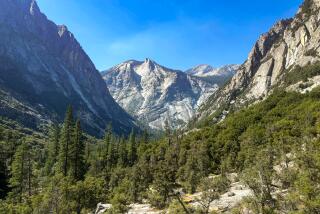‘Sky Island’ Returns to Its Natural State
- Share via
SIERRA VISTA, Ariz. — Chock full of diverse wildlife, scenic Ramsey Canyon sits at the juncture of the Chihuahuan and Sonoran deserts and where the Sierra Madre and the Rocky Mountains end.
The Nature Conservancy spent a year and $800,000 to restore the scenic canyon’s habitat. Now visitors once again will be able to marvel at the splendors of the mile-high “sky island” canyon--what state director Les Corey calls one of the national environmental organization’s “flagship preserves.”
The public will be able to view the group’s handiwork when the 380-acre ecological jewel reopens today.
The canyon, a Madrean oak woodland in southeastern Arizona, traditionally draws more than 30,000 visitors a year and is popular among birders worldwide. Sky islands are biologically diverse high-elevation ecosystems with a range of plant and animal life.
Ramsey Canyon is home to 210 species of birds, including 13 varieties of hummingbirds, 420 varieties of plants, 45 animal species--black bears to coatimundi--and 20 species of amphibians and reptiles.
“Ramsey has been a fantastic draw as a place to observe wildlife for many years,” said Holly Richter, the Nature Conservancy’s riparian ecologist who supervised some of the restoration. “Now it’s not only a place to observe but to participate in wildlife and in ecosystem management and to learn more about conservation than you could in the past.”
The preserve, about 90 miles southeast of Tucson, was established in 1974 after Dr. Nelson C. Bledsoe willed the Nature Conservancy his 280-acre nature sanctuary south of Sierra Vista in the Huachuca Mountains.
A year later, the conservancy added 20 acres. A residence subsequently was converted to a visitors center and six guest cottages. The organization acquired 80 more acres, adding two more riparian areas along Ramsey Creek and a buffer to encroaching development along the canyon’s gateway.
Among other things, the restoration campaign was undertaken to remove the aging cottages, outbuildings, retaining walls and septic tanks from the canyon’s riparian area and flood plain.
Corey and Richter said the conservancy wanted to allow an unrestricted water flow within the natural flood plain.
The structures had channelized Ramsey Creek, a spring-fed tributary of the San Pedro River that flows within the canyon, and had confined the flow of water.
The renovation also was intended to offer the preserve as a model for riparian restoration and to heighten visitors’ experiences by offering new programs, Corey said.
Also added were several parking spaces. The visitors center was upgraded and expanded, and the lost housing was replaced by a bed-and-breakfast operation near the preserve’s entrance.
Native plants, including grasses and shrubs, were dug up, potted and stored in a greenhouse while conditions were restored along 800 feet of the creek, including the flood plain.
Workers and volunteers tore out thousands of trash bags’ worth of a plant called vinca, a streamside-invasive ground cover native to Switzerland. Then they restored the canyon’s natural contours and replanted the native plants--including wildflowers and grasses, shrubs and vines--and added ash, New Mexico locust and big-tooth maple trees.
The creek includes a narrow band of riparian forest dominated by Arizona sycamore, locust, ash, cottonwood and walnut trees, Richter said.
“I’m incredibly pleased,” said Richter, who credited “literally a cast of thousands” of volunteers for their grueling work.
“You can stand at the visitors center and look up Ramsey Creek, and it looks like there was never anything man-made there,” he said. “You see a natural flood plain and native vegetation and a creek that appears to be unbridled by any kind of structures.”
More to Read
Sign up for The Wild
We’ll help you find the best places to hike, bike and run, as well as the perfect silent spots for meditation and yoga.
You may occasionally receive promotional content from the Los Angeles Times.






